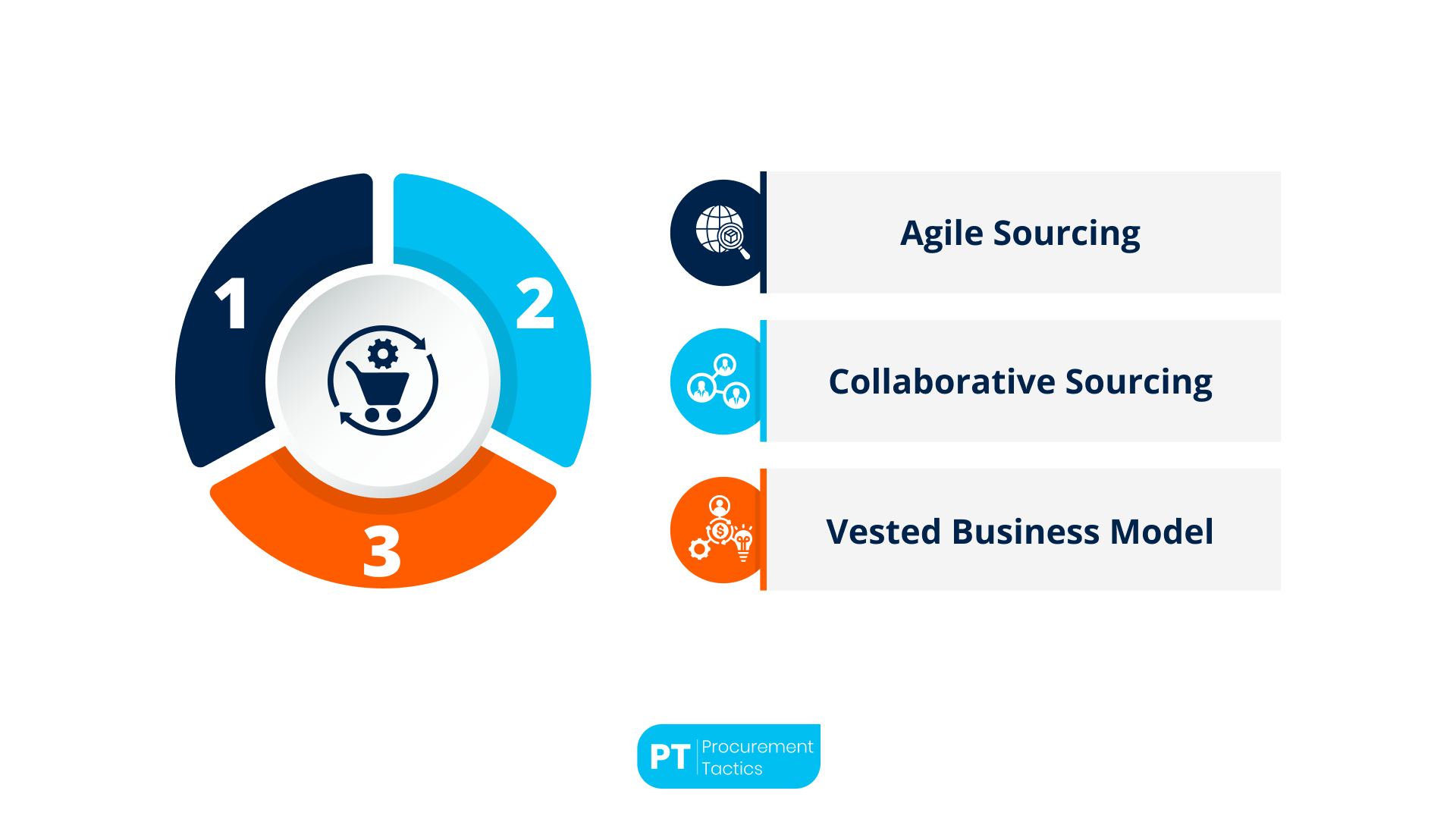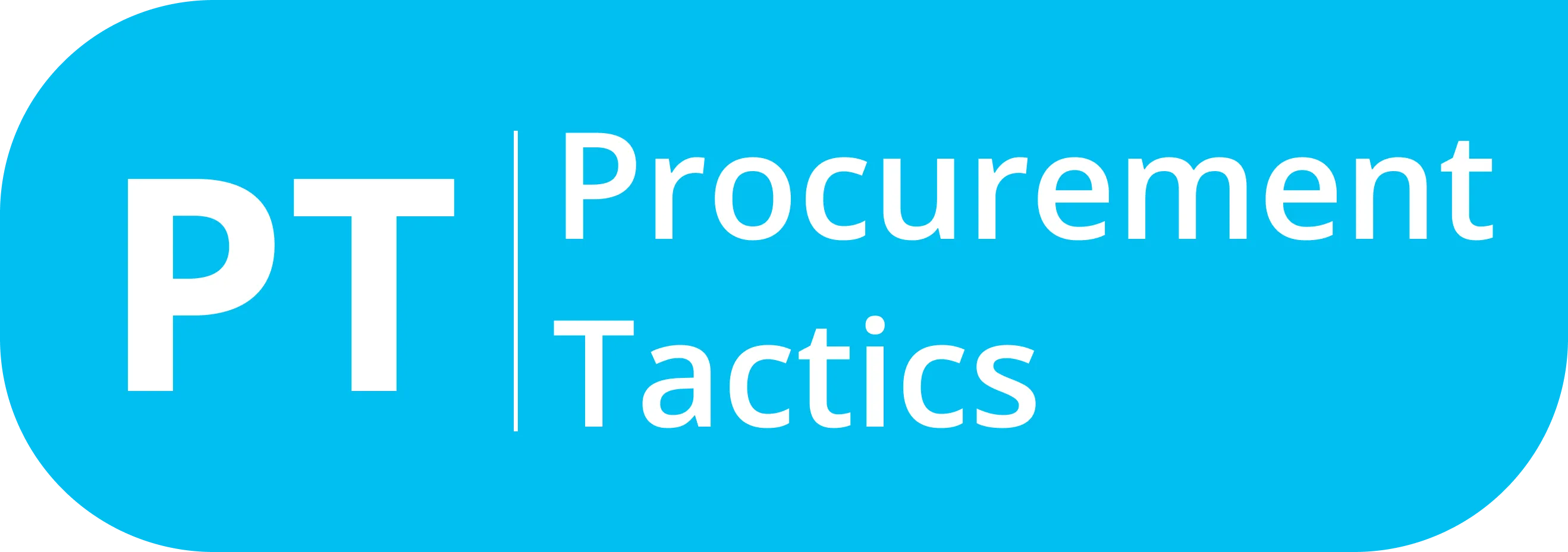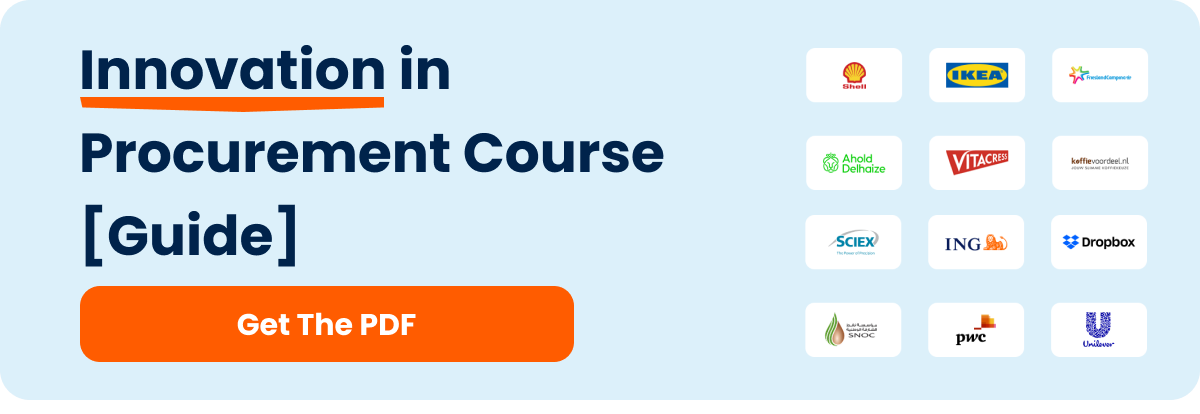Written by Marijn Overvest | Reviewed by Sjoerd Goedhart | Fact Checked by Ruud Emonds | Our editorial policy
Innovative Ways of Approaching the Procurement Process

As taught in the Innovation in Procurement Course / ★★★★★ 4.9 rating
What are the three innovative ways to approach the procurement process?
- The three innovative sourcing methods include Agile Sourcing and Collaborative Sourcing, and the Vested Business Model. These procurement methods work together to create flexible systems that enhance supplier partnerships along with strategic and value-based procurement relationships.
- Agile sourcing emphasizes flexibility through collaborative methods, which empower them to meet unexpected changes rapidly.
- Collaborative sourcing emphasizes developing solutions that produce enduring value and competitive benefits. On the other hand, the Vested Business Model focuses on forging mutually advantageous relationships anchored on strategic partnerships with suppliers.
In this article, we will be exploring the three innovative ways of approaching the procurement process. Let’s start!
The Three Innovative Ways to Approach the Procurement Process

1. Agile Sourcing
Agile sourcing is a collaborative and adaptable procurement process that prioritizes flexibility, supplier involvement, and urgency. It enables procurement teams to quickly respond by concentrating on achieving a result instead of following a predetermined path.
Such an approach improves upon the previous sourcing technique, which follows a defined process, or what is more commonly referred to as a “waterfall” approach, where each step must be finished before moving onto the next one.
That method restrained the supplier in terms of bidding opportunities and provided no opportunity for any deviation from the chosen means of use. It frequently resulted in unnecessary delays and lost opportunities for innovation or significant cost reductions.
Each of the seven steps in the procurement process is critical, and in an agile approach, any order of these steps can be taken. Such latitude enhances time to market speed, accompanied by reliance on a collective, outcome-focused model where interactions between buyers and suppliers are continuous.
2. Collaborative Sourcing
Collaborative sourcing is an innovative and partnership-based approach that focuses on mutual value, long-term objectives, and shared interests. And it does so by co-developing solutions among the procuring organization, its internal stakeholders, and suppliers that deliver sustainable competitive advantages.
To implement collaborative sourcing successfully, procurement teams need to build the approach upon a culture of trust, be willing to invest in long-term partnerships, and maintain an ongoing conversation. Having clear performance metrics and regular discussions around those metrics helps keep the partnership sharp and productive in the face of changing market conditions.
3. Vested Business Model
The Vested Business Model is a collaborative sourcing approach that seeks to create highly strategic and mutually beneficial partnerships between buyers and suppliers.
In contrast with traditional sourcing relationships, which generally experience win-lose dynamics, Vested sourcing promotes a win-win mindset that gives both parties equal stakes in each other’s ongoing success.
The Vested Business Model, developed through the University of Tennessee’s award-winning research with Air Force funding, has proved itself as an effective framework for associations moving from standard procurement to purposeful collaboration models.
This model is grounded in three core principles:
1. Shared value Approach – Emphasis is given to co-create value for the buyer and the supplier.
2. Relational/Behavioral Economics – Emphasizes the role of trust, collaboration, and behavioral dynamics in shaping business outcomes.
3. Outcome-Based Approach – Takes the focus away from inputs that are transactional to outcomes of performance, whereby suppliers are compensated based on the results they produce.
Through the Vested model, organizations achieve enhanced innovation together with improved accountability, coupled with continuous improvement due to its incentive alignment methods and outcome-focused approach.
Through these partnerships, suppliers can present brand-new suggestions that create mutual benefits, which enhance operational effectiveness and market position.
The Key Benefits of Each Approach in Procurement
Conclusion
The need to adopt innovative approaches in procurement emerges from advancements in market dynamics, execution, and increasing business complexities.
Through agile sourcing, organizations gain the power to accomplish their goals by remaining adaptable during changes.
During collaborative sourcing, companies merge supplier partnerships with internal teams to create sustainable long-term value while handling changing business needs.
As a modern procurement approach, the Vested Business Model establishes new supplier-buyer links that unite strategic targets and drive cooperative advancement beyond success maintenance.
These different innovative approaches to procurement unite their individual strengths through their shared purpose to transform procurement operations into a business growth accelerator with enhanced stability.
With these procurement framework models, procurement professionals can access heightened levels of efficiency, innovation, and trust, which create superior supply chains and superior business performance.
Frequentlyasked questions
What are the three innovative ways to approach procurement?
The three innovative procurement approaches are Agile Sourcing, Collaborative Sourcing, and the Vested Business Model. These methods focus on flexibility, strategic partnerships, and outcome-based value rather than traditional, step-by-step sourcing processes.
Are these models suitable for all supplier relationships?
Not necessarily. These innovative models are best suited for strategic suppliers or high-impact projects where collaboration and performance outcomes can significantly influence business success. For routine or low-value purchases, traditional methods may still be appropriate.
What is the biggest challenge when shifting to these new procurement models?
One of the biggest challenges is the cultural shift required—moving from control and compliance to trust, collaboration, and shared accountability. It often requires retraining teams, redefining processes, and establishing new ways to measure success.
About the author
My name is Marijn Overvest, I’m the founder of Procurement Tactics. I have a deep passion for procurement, and I’ve upskilled over 200 procurement teams from all over the world. When I’m not working, I love running and cycling.






